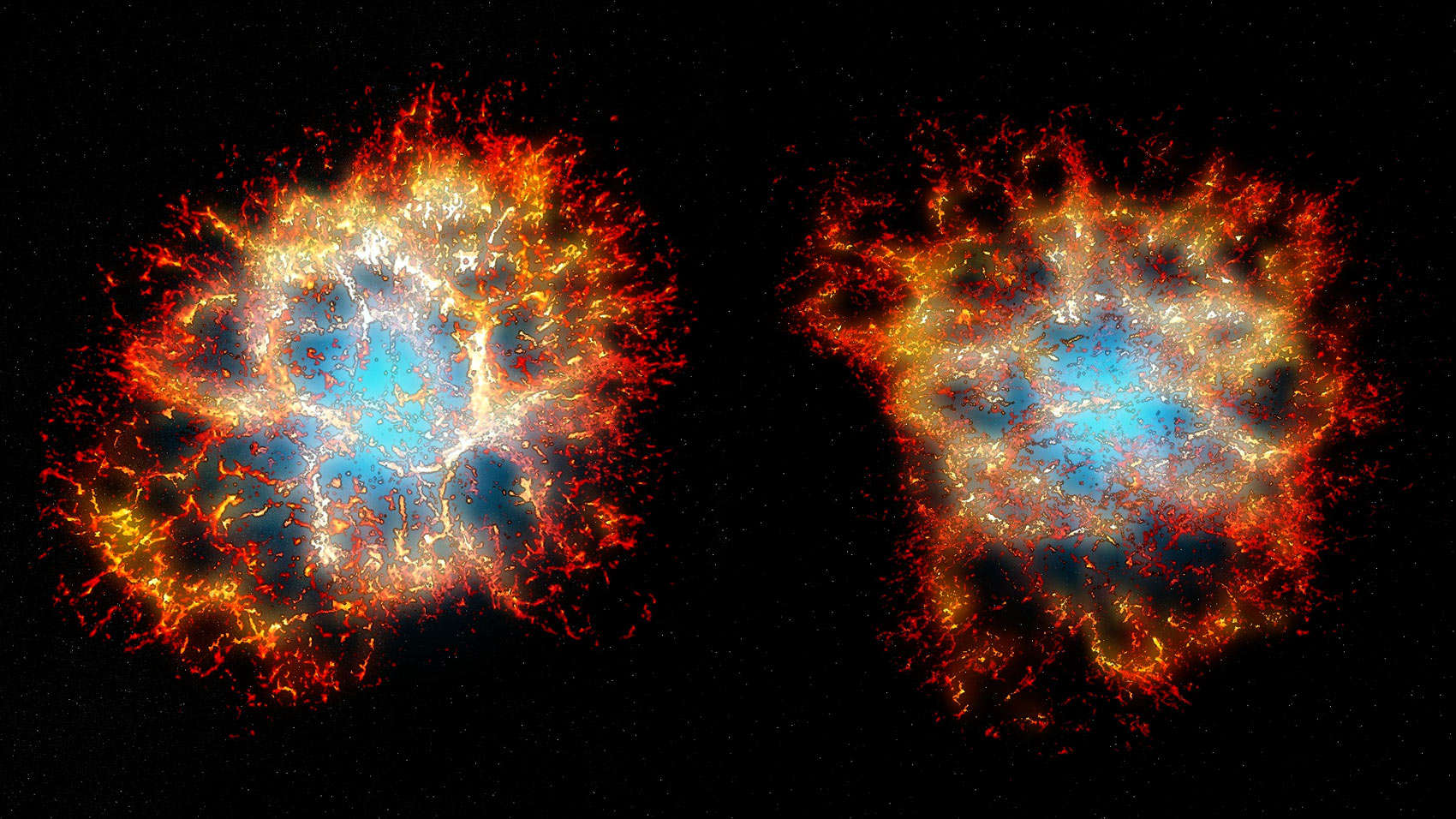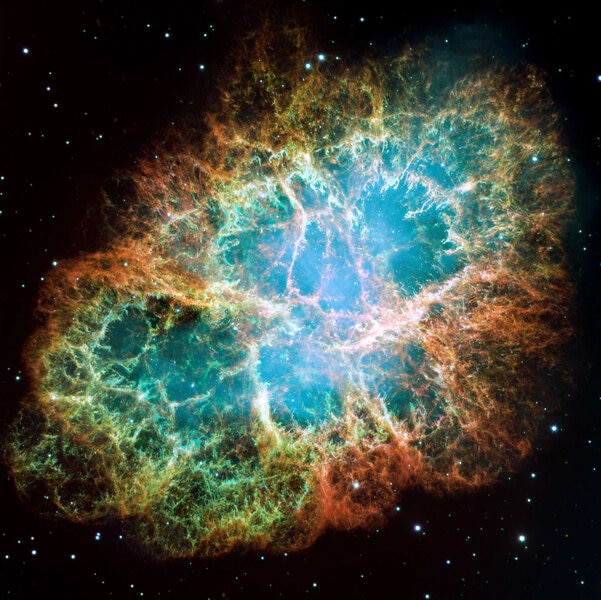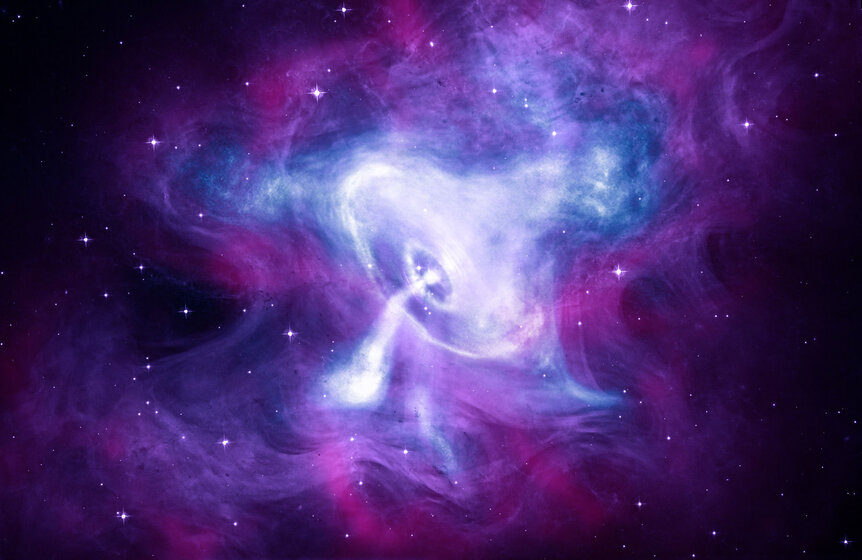Create a free profile to get unlimited access to exclusive videos, sweepstakes, and more!
The 3D heart of the Crab Nebula

Astronomers have done something very cool: Made a 3D map of the expanding debris from the supernova explosion that created the Crab Nebula, one of the closest and brightest such supernova remnants in the sky.
By creating a model of the 3D shape, it's possible to virtually observe the nebula from any direction, and to their surprise the astronomers found it's not an ellipsoid (like a the shape of an American football) as thought, but actually shaped like a heart. In this case I mean a cardioid, a valentine, like one of the plastic valentine-shaped cases filled with candies you can get in February for your sweetie*.
They also used the structure to figure some things out about the star that exploded, too, but first you'll need a wee bit of background.
One of the most amazing and colossal events in the Universe is when a massive star ends its life as a supernova.
The core of the star collapses, forming a neutron star or black hole, and releases just mind-vaporizingly amounts of energy, equal to the luminosity of an entire galaxy of a hundred billion stars. The blast wave plows through the star's outer layers, flinging them away at speeds of thousands of kilometers per second. The expanding debris is called a supernova remnant, and can continue to flow away from the supernova into space for many thousands of years.
... like in the Crab Nebula, a couple of octillion tons of highly energized matter screaming away from a pulsar, a rapidly rotating neutron star that used to be the progenitor star's core. It's about 6,500 light years away, close enough to be visible through binoculars or small telescopes, and it's been studied so thoroughly that for a long time astronomers would joke that astronomy could be divided into two disciplines: The Crab, and everything else.
Despite this, we don't have a firm grasp on what the star was like before it exploded. Models predict it should have been somewhere between 8 to 13 times the mass of the Sun, but it's difficult to constrain it more. They also predict it exploded when the core of the star was mostly oxygen, neon, and magnesium; crushed into a ball of what's called degenerate matter, where bizarre quantum mechanical laws rule. At some point the magnesium in the core started gobbling up electrons, which are needed to support the immense weight of the core. With the electrons gone the core collapsed, and, well, BANG.
But is that the case? One way to find out is to study the remnant itself, which has a lot of the initial explosion imprinted on its structure.
That's not easy, though. The outer part of the nebula (called the thermal ejecta, the material blasted away that's glowing due to heat) is highly filamentary, like hundreds of little overlapping tendrils.
However, in principle there's a technique that can be used. This gas was blown out in an explosion, which means it was all in one spot — the supernova event — in the past. If you can find the velocity of each bit of gas that tells you how far it is from the center (distance = velocity x time, and we know the supernova went off in July 1054). That gives you the 3D structure!
Well, sure, but of course it's still actually super complicated. It's been done with some success before, but a new camera on the Canada France Hawaii Telescope, called SITELLE (for Spectromètre Imageur à Transformée de Fourier pour l'Etude en Long et en Large de raies d'Emission, which roughly means a Fourier Transform Imaging Spectrometer for Long and Wide Study of Emission Lines, if that helps). The technique it uses is subtle and complex, but in the end what you wind up getting is a high-resolution spectrum of the nebula on every pixel of the camera.
OK, one more aside: A spectrum is when you break up the light coming from an object into different wavelengths (like colors), which can tell you a lot about an object, like its temperature, rotation, and composition. Different elements also emit or absorb light at very specific wavelengths, and these can be shifted by the velocity of the gas (in the same way sound can get its pitch shifted, say as a motorcycle drives past you, what's called the Doppler shift).
So, by measuring the Doppler shift of the gas we get the velocity of every part of the nebula, its speed toward or away from us as the remnant expands.
<tl;dr> The astronomers used a fancy camera and sophisticated software to map the 3D structure of the Crab Nebula. </tl;dr>
When they rotated the 3D model of the Crab around, they found the heart-shaped pattern to the ejected material. Here's an interesting bit: The pulsar is blowing a wind of particles away from itself, filling the interior of the nebula with extremely energetic gas. There's a torus, a doughnut-shaped structure surrounding the pulsar, and the outer nebula seems to be symmetric around that.
This may be due to a ring of material blown off the star from its equator before it exploded. It's not clear why that might have happened. It may have engulfed a companion star while it was still a red giant, which would increase the progenitor star's spin flinging material away from itself. But when the star exploded its debris would hit that dense ring and be shaped by it; sturcture still seen today.
The outer nebula filaments, it turns out, are structured like honeycombs, which can be seen better in this 3D virtual fly-through of the nebula:
That gives some insight into the star that blew up. Due to the details of how elements are created in the nuclear fires of the supernova event, it favors the core being iron when it collapsed, and not oxygen-neon-magnesium. That's interesting! The supernova itself was brighter than average b y a factor of ten, but the energy of motion (the kinetic energy) of the debris is lower than your typical supernova by a factor of ten. This has always been a mystery, but a low-energy iron core collapse instead of it being O-Ne-Mg would go a long way to explain that.
The point here is that looking at the details structure of a supernova remnant can help astronomers understand the explosion itself. The team that created this map also plans on following up to look at different elements in the nebula to get even more details of the nebula, like the temperature and density, which again provide clues to the explosion and the star that caused it.
As a little reminder, the iron in your blood and the calcium in your bones (and the phosphorus in your DNA and a bunch of other elements we need to be alive) were literally created in an anonymous supernova explosion that occurred billions of years ago before the Sun was born. These elements were seeded into the gas cloud that collapsed to form the Sun, the planets, the Earth, and everything in it and on it, including, my friends, YOU.
So yeah, this stuff is complicated but it's also why we all exist. And that's a very good and very cool reason for astronomers to study and understand it.
*Or do what I do and wait until February 15 and buy them half-off for myself.





























